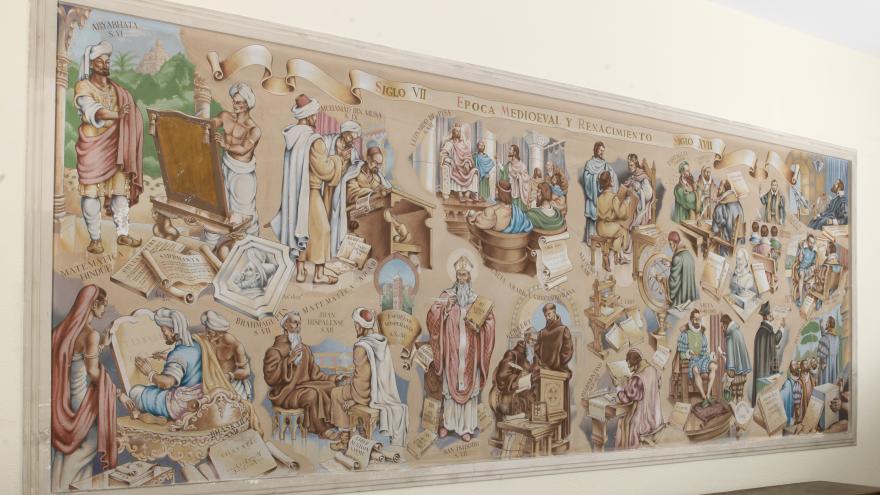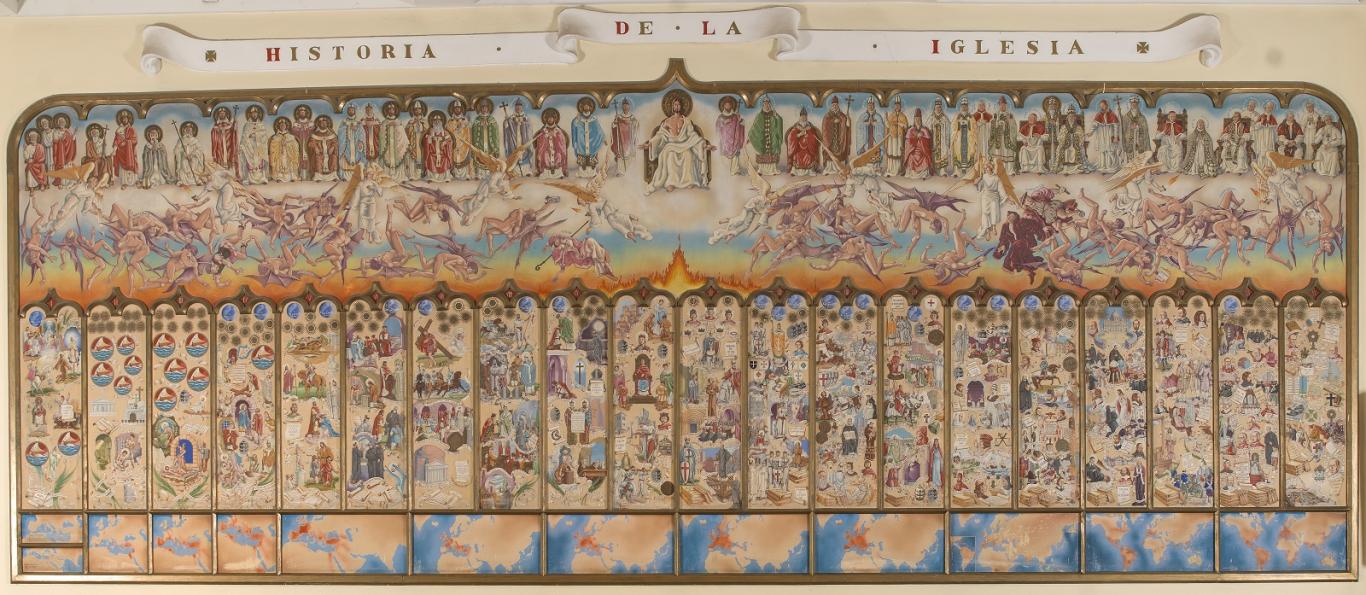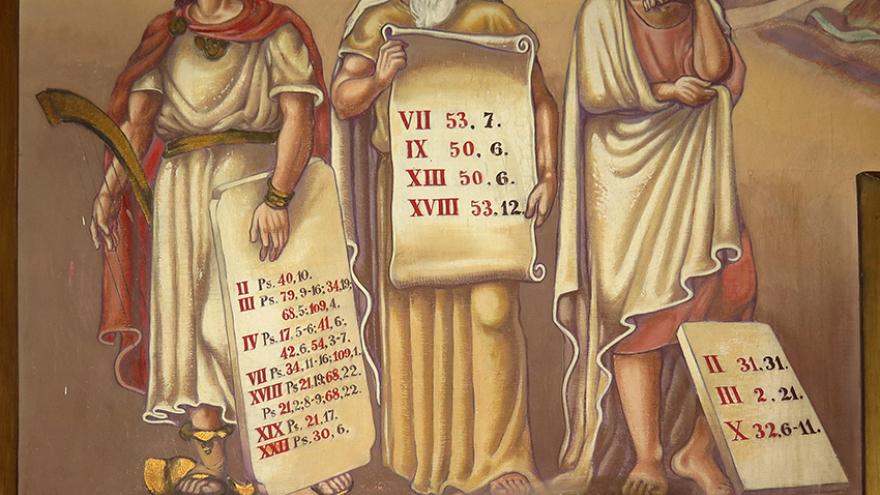

Restoration of the mural paintings of the IES Ramiro de Maeztu
Located in the Mathematics department and in the chapel
The Community of Madrid has a network of Historical Institutes, secondary schools created in the XNUMXth century and in the first third of the XNUMXth century, which guard and preserve cultural heritage assets of undoubted value. The name Historical Institutes refers to their patrimonial importance, on some occasions because of the building that houses them and on others, because of the documentary or instrumental pieces that they have managed to preserve.
In these institutes, collections of a very varied nature and surprising contents are preserved, with historical objects used in the teaching of subjects such as Biology, Geology, Physics, Chemistry and Mathematics. They range from anatomical, botanical and zoological models, collections of fossils and mineralogy and scientific-technological instruments, through historical maps for teaching Geography, models for explanations of Physics or Mathematics, musical instruments and works of art.
All these collections constitute an important fund of the historical heritage of the Community of Madrid that is largely unknown to the general public. For the purpose of their protection, conservation and enhancement, in 2019 the General Directorate of Cultural Heritage began a line of work with restoration interventions on assets from these collections, which is maintained to this day and which also meets their needs for preventive conservation.
The mural paintings of the IES Ramiro de Maeztu
The IES Ramiro de Maeztu has a good number of works of art that it has been accumulating throughout its historical evolution, including various mural paintings. Their state of conservation has required a series of conservation and restoration interventions to stop their deterioration. In 2020, a restoration campaign was started on various historical-artistic elements in an advanced state of deterioration.
The author:
Antonio Cobos (1908-2001), was born in Guadalajara into a wealthy family. In 1915 he moved to Madrid. He studied at the Jesuits where he began to excel in drawing. Later, while studying law, he will do his first jobs as an advertising cartoonist and book illustrator, work that he will continue after graduating.
After the Civil War he began teaching Art History at the Ramiro de Maeztu Institute, where he created a series of mural paintings in different rooms of the centre: the assembly hall, chapel and Mathematics department.
Restoration of the paintings in the Department of Mathematics
The paintings are made with the tempera technique on a plaster support. The letters are made in gold glitter except the initial of each word that is tempera in red.
These are four panels made on the longest walls of the Mathematics department, a large elongated room with large windows located on the short walls. All of them are framed with a plaster molding. Two of them, Early mathematical culture until the 6th century y 17th Century Modern and Contemporary Period 20th Century They are located on the wall of the access door which is interior, while the other two, 6th century Ancient Greece and Rome 7th century y 7th century Medieval and Renaissance Period 17th century They are on the opposite side, which is outside. This determines certain aspects of their state of conservation. Those located on the outside wall are more dirty due to the humidity and temperature changes to which they are exposed.
The date of execution of the paintings in the Mathematics classroom is the year 1946, all the panels are signed and dated by the author in the lower part, with dark earth-colored paint: "ANTONIO / COBOS / 46".
Description of the work carried out
Description of the work carried out
The paintings were generally dirty due to dust and environmental pollution, with small cracks in the walls, peeling of the paint layer with slight loss of polychromy, cracks in areas with greater paste and shine, as well as scratches and missing parts due to impacts on the lower part, accidentally caused by daily use of the Mathematics room where they are located. The interventions carried out were carried out in the following steps:
-
Cleaning:
Mainly dry and mechanical. The most embedded dirt and stains caused by inadequate cleaning, located mainly in the lower parts of the panels, were tried to be minimized as far as possible, with different soft erasers.
-
Consolidation and settlement of polychromy:
Due to the high porosity of the tempera, it had to be applied with great care so as not to saturate the paint and change its appearance. Once the treated areas had dried, the superficial remains of resin were removed to remove shine and saturation stains.
-
Filling of gaps. Coated:
Both the application of plaster and stucco as well as the removal of stucco were carried out with great care so as not to invade the edges of the gaps since the fragility of the tempering makes the procedure difficult.
-
Chromatic reintegration:
The gaps and worn areas were restored with watercolours. The outer frame was glazed with acrylic paint in a colour similar to the original. The lower areas were very dirty from previous cleaning with damp cloths.
-
Elimination of overpainting:
Repainting the panel 6th century ancient Greece and Rome 7th century It was removed with acetone and controlled humidity, and was then mechanically removed using a scalpel. It was reintegrated using acrylic colours in a mimetic manner.
With the treatments described, the restored wall paintings have recovered their original expressiveness.
Primitive Mathematical Culture Prior to SVI
XNUMXth century Ancient Times, Greece and Rome XNUMXth century
XNUMXth century Medieval Period and Renaissance XNUMXth century
XNUMXth century Modern and Contemporary Period XNUMXth century
Restoration of the chapel's mural paintings
El mural Church history It is a large mural made up of tempera-painted canvases glued to the wall. Each scene is framed by slats of stuccoed and gilded wood with glitter. It is located on the left wall of the Chapel-Museum, opposite another large mural dedicated to the life of Jesus.
The attic depicts the final judgement with the figure of Jesus enthroned alongside various Popes. Below them, demons burnt in the flames of hell. The next floor is made up of 20 vertical panels with the history of the Church, one for each century (from the XNUMXst to the XNUMXth) where religious buildings appear, historical figures such as emperors, kings, martyrs and events such as councils, symbolised by spheres of the world, persecutions against the Church, symbolised by sinking boats or religious orders, among other iconographies.
Church history
The paintings had various damages, specifically general dirt caused by dust and environmental pollution, especially in the upper areas of the frame and in the plaster phylactery with the title at the top. Some thumbtacks were also found in these areas.
There was also a noticeable loss of polychromy, especially on the lower panels. Some of the missing polychromy was caused by inadequate cleaning and others by the passage of time. They also had stains from splashes of unknown origin, perhaps due to renovations of the room where they were located.
The frame had small cracks at the top and oxidation of the glitter in the gilded areas. Several of the central canvases were detached and slightly deformed.
Description of the work carried out in Church History
Firstly, a preliminary study was carried out with paint consistency tests and suitability tests of different consolidants, adhesives and solvents, in order to determine the most suitable products to be used.
-
Cleaning and stabilizing canvases:
Cleaning of pollution and dirt and stains from inadequate cleaning, as well as of the gilded mouldings. Removing the tacks and stabilising the 10th century canvas which, in the lower part, was deformed on its lower horizontal edge as it was not held in place by tacks, like the rest of the canvases.
-
Chromatic reintegration:
The gaps and worn areas were reintegrated with watercolours. The stains that could not be removed were reintegrated on top with soft pastel/watercolour pencils.
In 2023, restoration work continued on the rest of the mural paintings located in the chapel. The painting Life of Our Lord Jesus Christ It is made up of three large tempera-painted canvases glued to the wall. Each scene is framed by slats of stuccoed and gilded wood with glitter, with the titles: Childhood and 1st year of public life, Passion and Resurrection, and 2nd and 3rd year of public life.
In the first and third panels, based on a large map of Palestine, the main events of Jesus' life are narrated. In the second panel Passion and Resurrection A map of the city of Jerusalem in the time of Jesus is illustrated.
The paintings were damaged in various ways and were covered by widespread dirt from dust and environmental pollution, especially in the upper areas of the frame. Some drawing pins and drops of paint from the wall were also found.
The central panel had black stains in some areas caused by the oxidation of the glitter due to contact with water. There were also splashes of water, some of which were large, which had swept away the polychrome, leaving a darkened edge. In some areas the paint had dissolved, giving a lighter appearance.
On the other hand, the floods that occurred during 2020 caused leaks that caused damage to the works.
Description of the works carried out in the Life of our Lord Jesus Christ
Following a preliminary study of the state of conservation of the work, it was determined that the treatments should be predominantly dry, applied mechanically. The interventions carried out have been carried out in the following steps:
-
Cleaning and stabilizing fabrics:
A general initial cleaning was carried out with brushes and regulated vacuuming to remove accumulated dust, followed by a deep cleaning of embedded dirt and dust. Rubbers of different hardness were used to minimise stains as far as possible.
The gold mouldings were cleaned with cotton swabs moistened with water and dried quickly to prevent further oxidation. The thumbtacks were removed with pliers.
-
Chromatic reintegration:
Losses and worn areas of the polychrome were replaced with watercolours and the missing parts of the thicker white phylacteries were replaced with tempera. Stains that could not be removed were replaced on top with soft watercolour pastel pencils.
The missing and worn gilding was replaced with imitation gold watercolour, and the volumetric defects in the frame with a resin suitable for wood, followed by stuccoing.






















